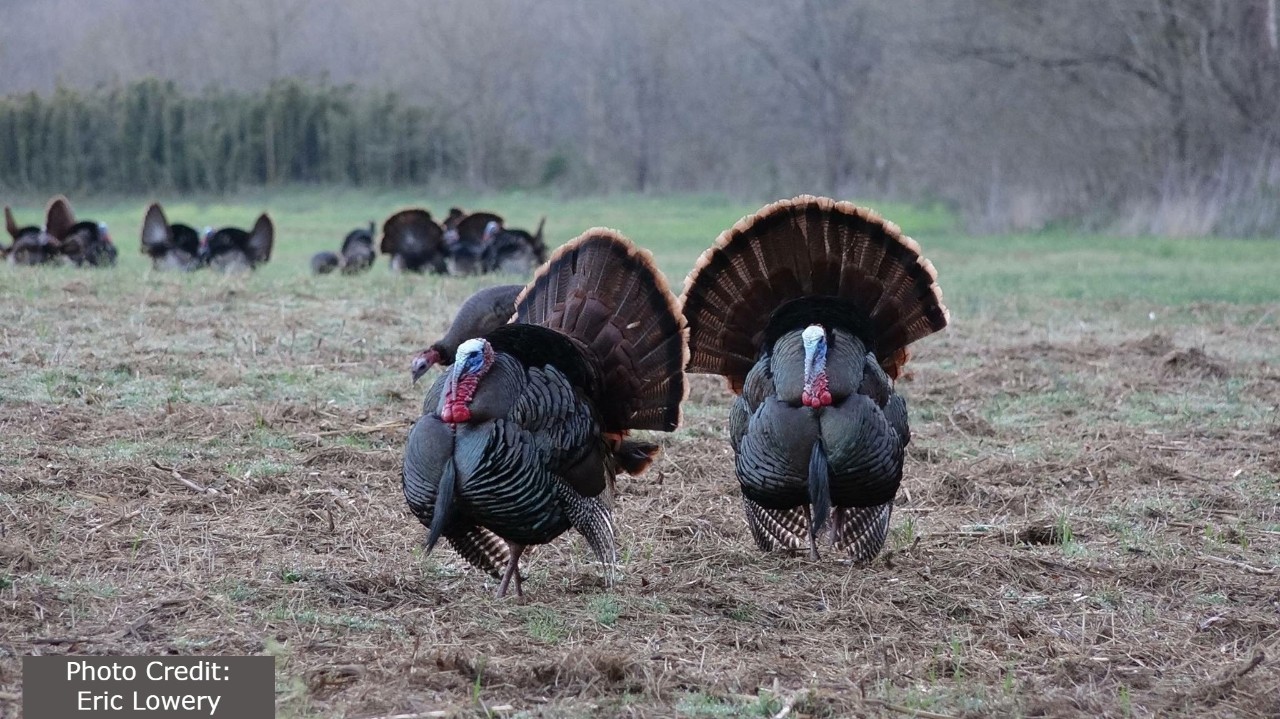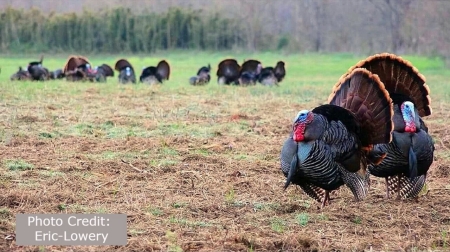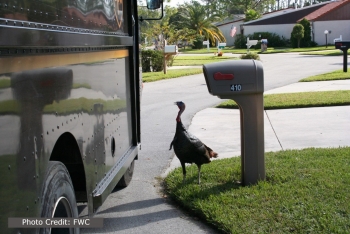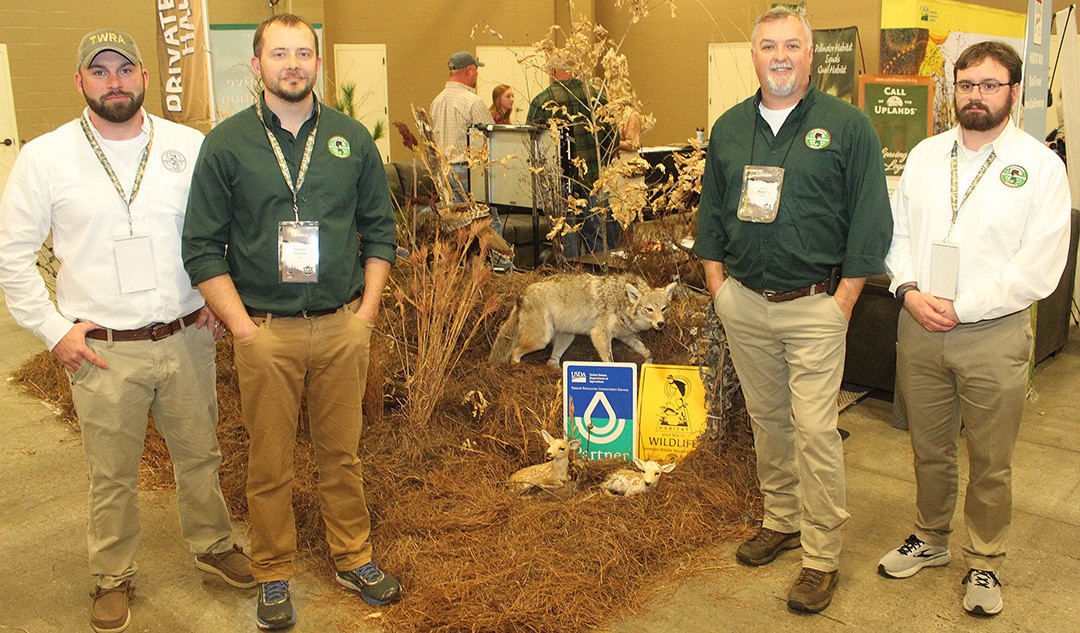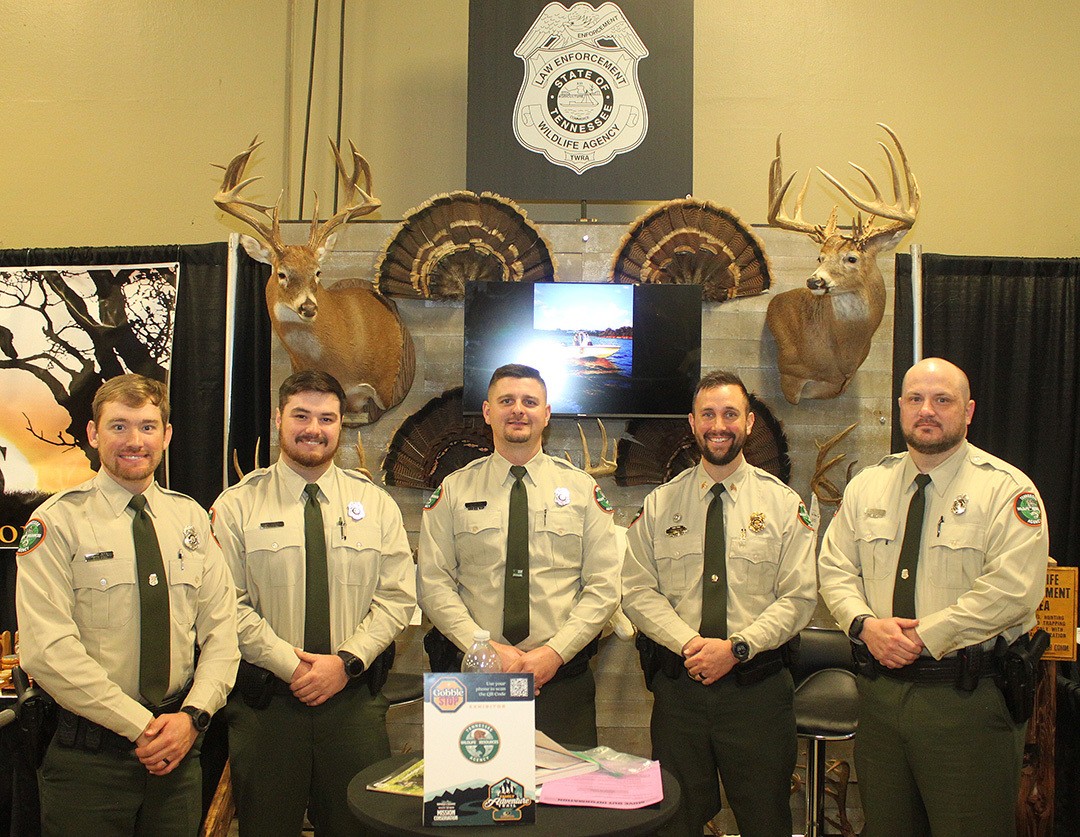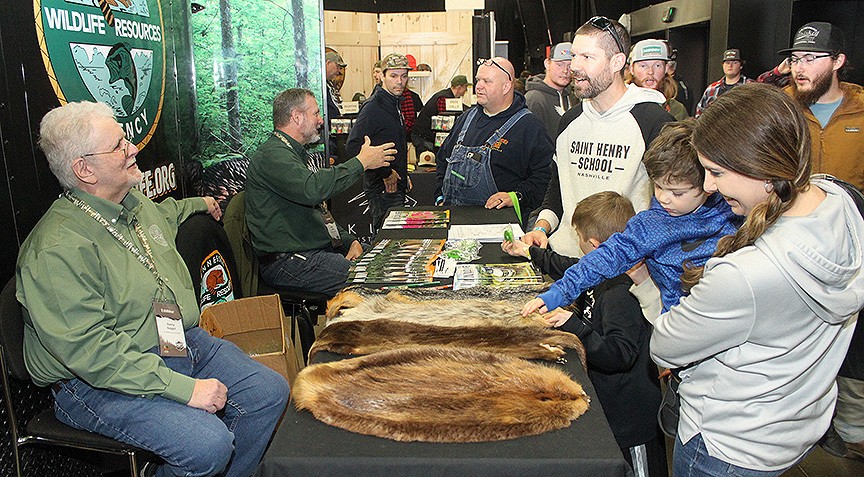Wild Turkey
Meleagris gallopavoWild Turkeys are the largest bird nesting in Tennessee. This large-bodied, big-footed species only fly short distances, but roosts in trees at night. The historic range of Wild Turkey extended from southern Canada throughout the United States to central Mexico. The eastern subspecies occur in Tennessee.
It was a very important food animal to Native Americans and early settlers, but by the early 1900s over-hunting eliminated this species from most of its range, including much of Tennessee. Modern wildlife management has reestablished this bird throughout its historic range and in 49 of the 50 United States.
Description: A Wild Turkey is a large, dark ground-dwelling bird. Males are larger than females. In late winter and spring when the male is courting females, he has a white forehead, bright blue face, and scarlet neck. All males and some females have a tuft of modified feathers on the chest called a beard.
Length: Male 46", Female 37"
Wingspan: Male 64", Female 50"
Weight: Male 16.2 lbs., Female 9.2 lbs.
Voice: Male makes a fast descending gobble, gobble, gobble and females make a loud, sharp tuk, similar to a chipmunk.
Similar Species:
Domestic turkeys can look similar but have a white tip to the tail (similar to some of the western U.S. subspecies).
Habitat: Mature woodlands with scattered openings or fields.
Diet: Acorns, nuts, seeds, fruits, insects, buds, fern fronds, salamanders.
Nesting and reproduction: Males begin vying for females starting in late winter or early spring and attract females by gobbling. When the female appears, he puffs up his body feathers, and struts around her with his tail spread and wingtips dragging on the ground.
Dominant males will mate with several females in one season, but the female alone builds the nest and cares for the young.
Clutch Size: Ranges from 7 to 14 eggs with an average of 11 eggs.
Incubation: The female incubates the eggs for 27 to 28 days.
Fledging: The young leave the nest shortly after hatching and follow the female. They begin to fly at 6 to 10 days old. Male young remain with the female until the fall; female young remain with the female until the spring.
Nest: The nest is a simple depression on the ground lined with dead leaves or grass, usually placed at the base of a tree or bush and concealed in thick vegetation.
Status in Tennessee: Wild Turkey is a common to uncommon permanent resident throughout the state. By the early 1900s populations had crashed due to unrestricted hunting, land clearing, and the loss of the American Chestnut, which was an important food source.
As a result of reintroduction efforts by TWRA, Wild Turkeys are now found in every county in the state. Winter flocks in Tennessee may exceed 400 individuals.
Fun Facts:
- Wild Turkeys are native to North America and are one of only two bird species domesticated in the New World; the other is the Muscovy Duck.
- In the early 1500s, European explorers took Wild Turkeys from Mexico for domestication in Europe. When Europeans colonized the Atlantic Coast, they brought these domesticated turkeys with them. The Mexican subspecies have a white tip to the tail and this trait can be used in part to distinguish wild from domestic birds.
- The male Wild Turkey provides no parental care. The female alone incubates the eggs. The young follow her immediately after hatching, and quickly learn to catch food for themselves. Several females and their broods may form flocks of 30 or more birds.
Best places to see in Tennessee: Found in every county in the state.
For more information: National Wild Turkey Federation
HELP KEEP WILD TURKEYS WILD!
Most people enjoy observing wildlife, including wild turkeys, and what better way to see them often than to provide food to attract them to your neighborhood? While this might seem reasonable, what seems like a harmless (or even helpful) practice is not helpful to the turkeys and usually becomes a problem, and can even become a public safety threat—if not for you, then for a neighbor.
Please Do Not Feed Wild Turkeys
Turkeys are opportunistic foragers with a very generalist diet—there’s not much that they don’t eat. So, it is extremely rare that they cannot find enough to eat on their own. Of course, what turkey wouldn’t pass up an easy quick meal from a bird feeder or corn pile? But such food sources can actually be detrimental to the overall health of a turkey population and can lead to unpleasant outcomes for people in the area.
What’s the Harm of Feeding Turkeys?
Turkeys are supposed to move widely and cover large land areas while foraging throughout the day. While feeding turkeys in residential areas, whether directly or indirectly, seems like it is helpful, repeatedly congregating turkeys in the same area leads to a build-up of droppings and unnaturally increases contact between groups of turkeys. Such conditions produce the perfect environment for disease outbreaks and the spread of disease through a population. Further, feed that is not cleaned up regularly can spoil and mold, which leads to the production of toxic chemicals extremely harmful when ingested by turkeys.
Another problem with feeding turkeys in residential areas is that as turkeys get accustomed to being fed and seeing people, they habituate to people and lose their natural fear of humans. For a while, this may seem wonderful because people are able to watch turkey behavior up close, even from the comfort of their own homes at times. However, having turkeys hanging around neighborhoods eventually leads to issues with turkeys scratching up flower beds, pecking cars, and leaving droppings on driveways, sidewalks, yards, and porches. Turkeys disrupt and block the flow of traffic when they congregate in roadways and intersections. They have even been known to roost on roofs or pool patio screens.
Turkeys Can Become Aggressive
While much of turkey nuisance behavior is relatively benign, over time turkeys begin to show bold and aggressive behavior towards people—particularly children, women, the elderly, and anybody who acts fearful and timid. These turkeys react to people (and sometimes pets) as they would a rival turkey. Once this bold behavior is established, it can be very difficult to change.
The best way to prevent turkeys from becoming too used to people and turning aggressive is simply to not feed them and don’t let them become accustomed to living in and around people.
What Should You Do?
If you encounter wild turkeys that 1) do not move to avoid people, 2) approach people, pets, or vehicles, or 3) remain in yards or common areas loafing, TWRA recommends aggressive hazing to frighten turkeys out of these areas. Actions you can take to frighten turkeys include:
Chasing them (without making physical contact) while doing any of the following:
- Waving your arms or clapping your hands and yelling at them
- Making loud noises with an air horn or banging pots and pans together
- Waving or swatting at them with a broom
- Opening and closing a large umbrella while facing them
Spraying them with a strong jet from a water hose
Allowing a large dog on a leash to run and bark at them
Remember to be bold with offending turkeys: don’t let them intimidate you. Turkeys that repeatedly challenge or attack people may ultimately have to be destroyed. Keep turkeys wild to avoid these consequences. It is rarely an option to trap and relocate nuisance turkeys that have developed these behaviors.
Educate Your Neighbors
Finally, pass this information along share these tips with your neighbors, and encourage other adults in your neighborhood to follow these suggestions, too. Your efforts will be futile if neighbors are providing food or shelter for turkeys or neglecting to haze bold and aggressive acting turkeys as well. It requires the efforts of the entire neighborhood to help keep wild turkeys wild!
Agency Well-Represented at NWTF Annual Convention
TWRA had a strong presence at the Annual National Wild Turkey Federation Convention held at the Opryland Resorts and Convention Center. NCRS representatives were available to answer questions and provide information for landowners. Boating and Law Enforcement officers had a booth and answered numerous questions from convention goers. Outreach and Communications had a booth in the outside building adjacent to the main convention center.
